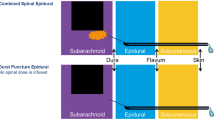Abstract
Since biblical times, the labor process has been recognized as being one of the most painful human experiences. Early treatments varied widely, according to the cultural and religious practices of the time. In the middle ages, treatments such as amulets, magic girdles, and readings from the Christian liturgy were considered to be appropriate treatment. More invasive pharmacologic treatments such as the use of soporific sponges (a mixture of biologically active plants, inhaled or ingested) were sufficiently potent to cause unconsciousness. Of interest, bloodletting was used until the middle of the nineteenth century to cause swooning and thus pain relief [1]
Access this chapter
Tax calculation will be finalised at checkout
Purchases are for personal use only
Similar content being viewed by others
References
Mander R (1998) Analgesia and anaesthesia in childbirth: obscurantism and obfuscation. J Adv Nurs 28:86– 93
Sackett DL, Rosenberg WM, Gray JA, Haynes RB, Richardson WS (1996) Evidence based medicine: what it is and what it isn’t. BMJ 312:71– 72
Chao AS, Chao A, Wang TH et al (2007) Pain relief by applying transcutaneous electrical nerve stimulation (TENS) on acupuncture points during the first stage of labor: a randomized double-blind placebo-controlled trial. Pain 127:214– 220
Bahasadri S, Ahmadi-Abhari S, Dehghani-Nik M, Habibi GR (2006) Subcutaneous sterile water injection for labour pain: a randomised controlled trial. Aust N Z J Obstet Gynaecol 46:102– 106
Wong CA, Scavone BM, Peaceman AM et al (2005) The risk of cesarean delivery with neuraxial analgesia given early versus late in labor. N Engl J Med 352:655– 665
Centre for Evidence Based Medicine, University of Oxford (2013) http://www.cebm.net/?o=1025. Retrieved 18 April 2014
Howick J, Chalmers I, Glasziou P et al (2011) The Oxford level of evidence 2. http://www.cebm.net/index.aspx?o=5653. Retrieved 10 Jan 2014
American Society of Anesthesiologists Task Force on Obstetric Anesthesia (2007) Practice guidelines for obstetric anesthesia: an updated report by the American society of anesthesiologists task force on obstetric anesthesia. Anesthesiology 106:843– 863
Obstetric Anaesthesia Special Interest Group (2008) Obstetric anaesthesia: scientific evidence, 1st edn. http://dbh.wikispaces.com/file/view/Obstetric+Anaesthesia+Scientific+Evidence.pdf. Retrieved 24 April 2014
Sultan P, Murphy C, Halpern S, Carvalho B (2013) The effect of low concentrations versus high concentrations of local anesthetics for labour analgesia on obstetric and anesthetic outcomes: a meta-analysis. Can J Anaesth 80:840– 853
Anim-Somuah M, Smyth RM, Jones L (2011) Epidural versus non- epidural or no analgesia in labour. Cochrane Database Syst Rev 12:CD000331
Leighton BL, Halpern SH (2002) The effects of epidural analgesia on labor, maternal, and neonatal outcomes: a systematic review. Am J Obstet Gynecol 186:S69–S77
Wassen MM, Zuijlen J, Roumen FJ et al (2011) Early versus late epidural analgesia and risk of instrumental delivery in nulliparous women: a systematic review. BJOG 118:655– 661
Simmons SW, Taghizadeh N, Dennis AT, Hughes D, Cyna AM (2012) Combined spinal-epidural versus epidural analgesia in labour. Cochrane Database Syst Rev 10:CD003401
van der Vyver M, Halpern S, Joseph G (2002) Patient-controlled epidural analgesia versus continuous infusion for labour analgesia: a meta-analysis. Br J Anaesth 89:459– 465
Halpern SH, Carvalho B (2009) Patient-controlled epidural analgesia for labor. Anesth Analg 108:921– 928
George RB, Allen TK, Habib AS (2013) Intermittent epidural bolus compared with continuous epidural infusions for labor analgesia: a systematic review and meta-analysis. Anesth Analg 116:133– 144
Halpern SH, Walsh V (2003) Epidural ropivacaine versus bupivacaine for labor: a meta-analysis. Anesth Analg 96:1473– 1479
Halpern SH, Breen TW, Campbell DC et al (2003) A multicenter, randomized, controlled trial comparing bupivacaine with ropivacaine for labor analgesia. Anesthesiology 98:1431– 1435
Douma MR, Verwey RA, Kam-Endtz CE, van der Linden PD, Stienstra R (2010) Obstetric analgesia: a comparison of patient-controlled meperidine, remifentanil, and fentanyl in labour. Br J Anaesth 104:209– 215
Ullman R, Smith LA, Burns E, Mori R, Dowswell T (2010) Parenteral opioids for maternal pain relief in labour. Cochrane Database Syst Rev 9:CD007396
Klomp T, van Poppel M, Jones L et al (2012) Inhaled analgesia for pain management in labour. Cochrane Database Syst Rev 9:CD009351
Dowswell T, Bedwell C, Lavender T, Neilson JP (2009) Transcutaneous electrical nerve stimulation (TENS) for pain relief in labour. Cochrane Database Syst Rev 2:CD007214
Derry S, Straube S, Moore RA, Hancock H, Collins SL (2012) Intracutaneous or subcutaneous sterile water injection compared with blinded controls for pain management in labour. Cochrane Database Syst Rev 2:CD009107
Smith CA, Collins CT, Crowther CA, Levett KM (2011) Acupuncture or acupressure for pain management in labour. Cochrane Database Syst Rev 7:CD009232
Author information
Authors and Affiliations
Corresponding author
Editor information
Editors and Affiliations
Rights and permissions
Copyright information
© 2015 Springer International Publishing Switzerland
About this chapter
Cite this chapter
Halpern, S.H., Garg, R. (2015). Evidence-Based Medicine and Labor Analgesia. In: Capogna, G. (eds) Epidural Labor Analgesia. Springer, Cham. https://doi.org/10.1007/978-3-319-13890-9_21
Download citation
DOI: https://doi.org/10.1007/978-3-319-13890-9_21
Published:
Publisher Name: Springer, Cham
Print ISBN: 978-3-319-13889-3
Online ISBN: 978-3-319-13890-9
eBook Packages: MedicineMedicine (R0)




